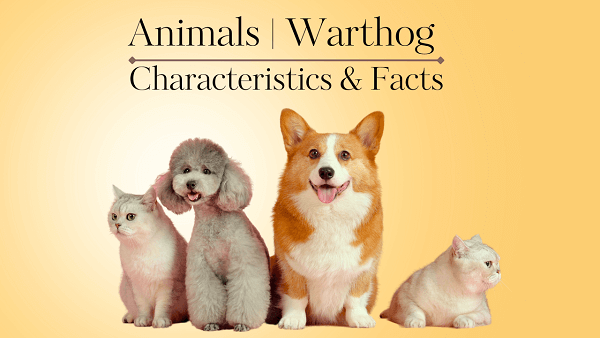
Warthog Definition | Characteristics & Facts
Warthog Definition
A warthog refers to a species of wild pig found in sub-Saharan Africa. Here's a definition of a warthog:
Warthog General Characteristics & Facts
Physical Description
Warthogs are medium-sized members of the pig family (Suidae). They have a compact, robust body with a large head and elongated snout. The average adult warthog stands around 2 to 3 feet (60 to 90 centimeters) tall at the shoulder and can weigh between 110 to 330 pounds (50 to 150 kilograms).
Distribution and Habitat
Warthogs are native to sub-Saharan Africa and can be found in a wide range of habitats, including grasslands, savannas, woodlands, and semi-desert areas. They are particularly common in East and Southern Africa.
Social Behavior
Warthogs lived in family groups called sounders. A typical sounder consists of a dominant male, several adult females, and their offspring. However, adult males may also lead solitary lives. They communicate using a variety of vocalizations, including grunts, snorts, and squeals.
Diet
Warthogs are omnivores with a predominantly herbivorous diet. They feed on grasses, roots, bulbs, tubers, fruits, and occasionally carrion. With their tough snouts, warthogs can kneel down on their calloused, bony wrists and dig for food, such as roots and tubers, in the ground.
Adaptations
Warthogs possess several unique adaptations that aid in their survival. They have large, sharp tusks that can be used for defense against predators and in fights with other warthogs. Their facial warts, which are actually thickened pads of skin, protect their eyes from injury during confrontations.
Predators
Despite their formidable appearance, warthogs are prey to numerous predators. Lions, leopards, cheetahs, hyenas, African wild dogs, and crocodiles are among the main predators that target warthogs. When threatened, warthogs will typically flee into burrows or run away, reaching impressive speeds of up to 34 miles per hour (55 kilometers per hour).
Reproduction
Female warthogs give birth to litters typically consisting of 2 to 4 piglets, although larger litters are possible. The piglets are born with a reddish-brown coloration and distinctive longitudinal stripes, which fade as they grow older. They are weaned after 4 to 6 months but may remain with their mother until they reach sexual maturity at around 18 months.
Conservation Status
Warthogs are currently classified as a species of "Least Concern" by the International Union for Conservation of Nature (IUCN). They have a relatively wide distribution and are not considered to be under significant threat. However, localized declines in some areas may occur due to habitat loss, hunting, and competition with domestic livestock.
Cultural Significance
In African cultures, warthogs have symbolic importance. Their image is often used in traditional masks, carvings, and artwork. They also play a role in African folklore and are sometimes associated with courage, strength, and resilience.
Continue To Explore All Animals That Start With W
Physical Characteristics of Warthog
- Body Shape and Size: Warthogs have a compact and stocky build with a barrel-shaped body. They have relatively short legs and a broad head. Adult warthogs can measure around 3 to 4.9 feet (90 to 150 centimeters) in length and stand about 2 to 3 feet (60 to 90 centimeters) tall at the shoulder. Their weight ranges from 110 to 330 pounds (50 to 150 kilograms), with males being larger and heavier than females.
- Facial Warts: One of the most distinctive features of warthogs is the presence of wart-like growths on their faces. These facial warts are actually thickened skin pads that are most prominent in adult males. The warts serve as protection during fights and can help cushion blows.
- Tusks: Warthogs have large, curved tusks that protrude from their mouths. The upper tusks are longer and more prominent than the lower ones. The tusks are actually elongated canine teeth and are used for defense against predators and in territorial disputes.
- Skin and Hair: The skin of warthogs is sparsely covered in bristly hair, with coarse black or brownish-gray bristles. They have sparse hair on their bodies, except for a mane of longer hair that runs along their spines, from the neck to the middle of the back.
- Facial Features: Warthogs have a relatively flat face with a broad snout. They have small, rounded ears and relatively small eyes. Their eyes are positioned on the sides of their heads, providing them with a wide field of vision.
- Tail: Warthogs have a long, thin tail that ends with a tuft of hair. The tail is held upright when the warthog runs, serving as a visual signal to other warthogs in the group.
- Wart Pads: Apart from the facial warts, warthogs also have large wart-like pads on their front knees. These pads provide protection when the warthog kneels down to feed on low-lying vegetation.
Scientific Classification of Warthog
Kingdom: Animalia (Animals)
Phylum: Chordata (Chordates)
Class: Mammalia (Mammals)
Order: Artiodactyla (Even-toed ungulates)
Family: Suidae (Pigs)
Genus: Phacochoerus
Species: Phacochoerus africa.
Key Locations of Warthog
- United States
- United Kingdom
- South Korea
- Germany
- France
- Greece
- Turkey
- Israel
- Saudi Arabia
- Egypt
- Jordan
- Kuwait
- Bahrain
- United Arab Emirates
- Thailand
- Singapore
View All A-Z Animals List
Warthog FAQs
What does Warthog eat?
Its diet consists of grasses, roots, fruits, tubers, and occasionally small invertebrates, making it a versatile and opportunistic feeder.




